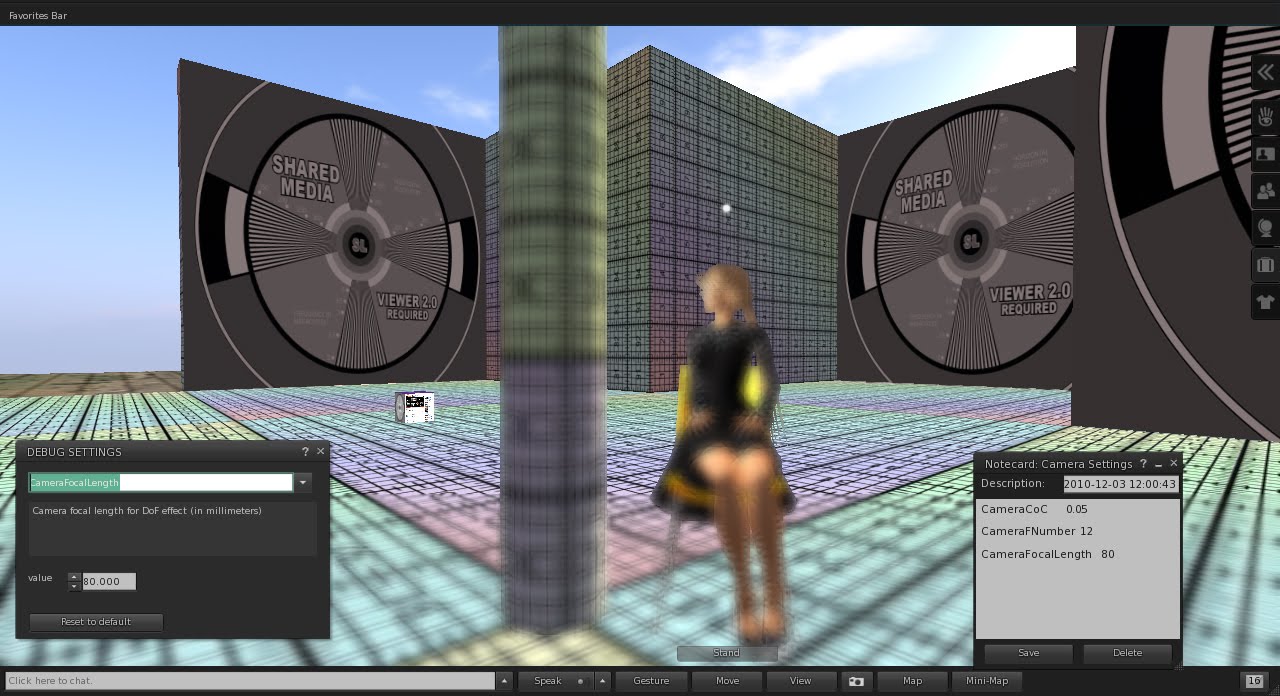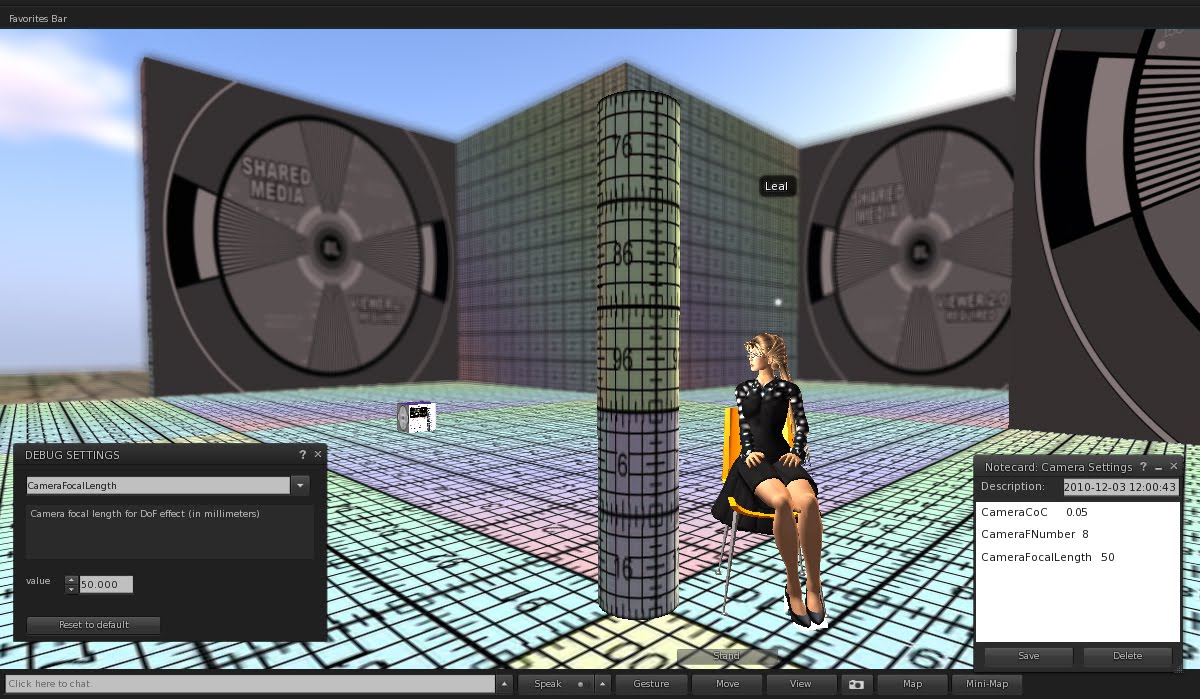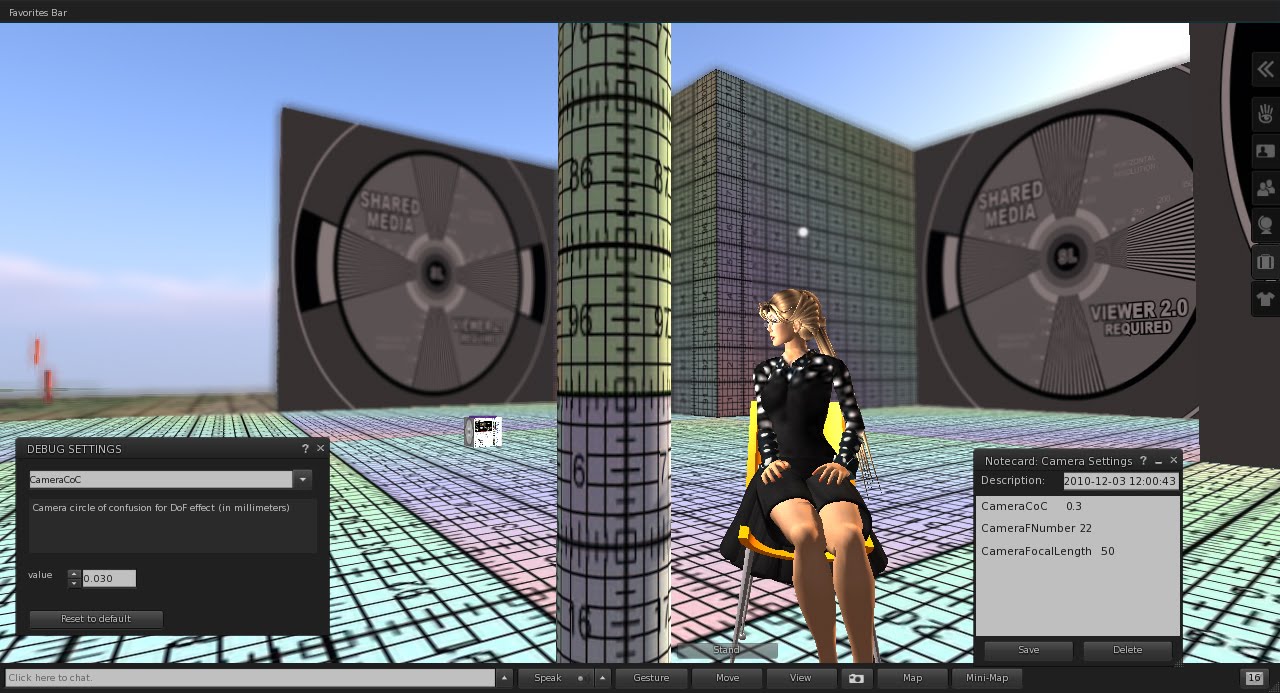-
Posts
179 -
Joined
-
Last visited
Content Type
Forums
Blogs
Knowledge Base
Blog Comments posted by Leal Choche
-
-
[TIP] *experimental* depth of field camera blur effect... / @ @ \
A group blog by Secondlife in General
Here are a few Snapshots using Camera Controls as noted. See the NoteCard in the Snapshot for the camera setting for CameraCoC, CameraFNumber and CameraFocalLength. The longer Focal Length does create a shorter depth of field, as well as making the CoC a bit smaller (0.30 as with 35mm file) The focus is either on the foreground object (cylinder) or in the distance (corner of the gridwall) One thing seems the change from blurr to sharp image seems more abrupt from a blurry foreground
See this Jira VWR-19244 for a discussion of this concept. The Camera control settings work slightly differently than envisioned in that Jira.




-
Well....yes other worldies will be disappointed. I would proffer that the acquisition of AU was of the SOP - Standard Operating Procedure - of many MBA - use a checkbook and purchase something 'like' you might want, rather than role up one's sleeves and tackle the problem head on. Ok...'nuf opinion there. Now....
Regarding Dashboard enhancements. I have wondered for a very long time when the Dashboard gets a real focus. This is not necessarily new news.
Refer to the following Jira for what can be done to enhance the Dashboard (please note that none of these have been "resolved" - but they are listed here to show that there are some who have a more holistic view of what can be done.
Jira VWR-18327 - "Snapshot Memories" - Shared Media Snapshot Viewer - Object to show streaming Snapshots from Dashboard Snapshot collection
Jira VWR-19134 - Save Snapshots to Dashboard as Option
Jira VWR-19135 - Viewer Snapshot Functions: Changes, Modifications and Enhancement Program Proposal
The bottom line here IS to have a way of sharing information with SL residents and non-residents alike.
@ ZenWarrior Fuosing - Permanent Email Address Yes yes yes yes!!!!
-
Hmmm…Not so sure that there is a need to “help the Lab figure out what the “X Factor” is going to be for Second Life.” That ‘X Factor’ is pretty much front and center. Let’s think about this for a moment…
Second Life is considered just one of many MMORPG – the Massively Multiple online role-playing games…except it isn't.
The difference between most all the other MMORPG – especially most of the one’s promulgated by Activision | Blizzard – and Second life, is the difference between getting a job and getting a life.
The other MMORPG are not called games for nothing. They are all highly scripted, optimized and structured activities that take place in virtual reality. While the participant may seem to have some freedoms, and even allowed some form of ‘mods’ to enhance their experience, nonetheless, they are confined to a certain world.
While MMORPG’s are structured, a structured environment should not necessarily be considered a ‘bad’ activity. In the end though, participating in a MMORPG is really no different than working at a job.
For some, the mystery of what the ‘game’ has in store is the elixir of the activity. Having a defined set of goals, one is able to spend one’s time participating with others, all the while there is a common measure of one’s activities that can then be compared with other participants. But, like a job, the participants work to achieve a prearranged goal or set of goals.
Second Life has two major characteristics that, together, distinguishes itself from almost every other MMORPG:
- Self-structured Concurrency – As with most other MMORPG, Second Life allows participants to share, in real time, the same virtual environment. The actual activity in Second Life is wholly structured by the participants themselves. Unlike other MMORPG – which, like most work environments – it is the participants (residents) of Second Life that decide how they will interact. This means, they may participate in heavily defined role playing (such as some sci-fi or “Gor” regions) or more loosely organized gatherings such as concerts or general life-style activities (beach combers)
- User-built environment – Unlike the vast majority of other MMORPG, the virtual environment found in Second Life is wholly created by its participants. This enormous freedom for creativity is both a strength and a major bane for Second Life users. The creative side allows for complete freedom (within, of course, the confines of the existing build tools using prims, etc.) of creating environments that can almost mirror or mimic most real life or dream-like fantasy situations. Second Life – for free – provides it participants the tools needed to create almost any virtual environment they may conceive of or desire. The bane, of course, is that the environments found in Second Life are not optimized as they are in the pre-ordained game environments. In those, every pixel is accounted for and optimized for an efficient 'low-lag' experience.
In many ventures into MMORPG’s, the ability to participate and 'lose' oneself in a world that has rules is in and of itself a way to relax - there is no need to have to make decisions other than to follow a simple decision tree, where the answer is not much more difficult than a yes or no, an up or down, right or left, start or stop.
The X Factor for Second Life is there is no decision tree one can follow. Like an ameba floating in the early primordial soup, one is able to inhabit a world, one that one has as much control over as one may wish (within certain technical boundaries, the discussion of which is outside this topic) and share it in real time with others.
Unlike all other computer games, where one has to ‘work to participate, Second Life is not a job, it’s a life.
Now, to take that and run with it, one may look about the real world and ask the question: Where are there people who want to get together, interact in real time, in a shared environment that they mutually understand or appreciate or want to be in, but can’t for more reasons than they may care.
They cannot have this mutual shared – concurrent – experience because they themselves may physically be limited in their mobility, or by a situation of time and place, they cannot have a physical presence with others. Second Life would allow any and all to overcome such limitations.
There are billions of people organized into millions of groups who want, need, or desire to have a shared spatial experience. Each of these groups is a candidate for using Second Life to overcome their physical limitations.
The common experience of entering any one particular part of Second Life is that the rest of Second Life is also open for exploring and participating in. Unlike the limitations of having one specific role at you job, Second Life is all about what happens AFTER one gets off work.
Perhaps it was the focus of trying to use Second Life as a tool for ‘work’ that the essence of Second Life was overlooked. Not that the role playing required of some work duties cannot be enhanced by using Second Life, it should be noted that Second Life can be whatever the participant wants it to be. The ‘only’ limit is one’s imaginations (and, again, foregoing discussion of the limitations of prim building, etc.)
With the right approach, Second Life can be quite relevant to real life. There are so many associations that could benefit from the use of Second Life – that would enhance ‘real life’ experience.
Wherever people gather to have a physical concurrent experience, Second Life could provide the alternative for those wanting to be there – in real life – but for whatever reason, can't. With a computer hooked up to the Internet (again, foregoing a technical discussion here) many millions of people would find Second Life to be a resource they would gladly use.
On a daily basis, millions of people are gathering together in churches, museums, clubs, in community meetings, at film festivals, plays, music concerts, trade shows, training sessions, schools, national parks, historic facilities, artistic events, and many more venues. Whether for (yes) work, play, business, or government, there are always times when not everyone can or has the ability to physically attend the event in real life. With a Second Life, they could.
The X Factor for Second Life is life itself. Second Life can make real life more relevant. It is not a substitute for real life, but a way for those who can't participate in real life, to have a life, by using Second Life.
Is such a concept a reasonable or compatible with the way Second Life has been both used and put forth up to now?
Well, of course it is!
To be in Second Life, one generally needs a reason to open the door and peek in. Once a person opens the door and enters Second Life, even if only for a limited purpose, the rest of the virtual world is then available to explore. With an entry ticket that costs basically nothing, there should be little to stop anyone from opening that door.
This, in due course, leads one to the Y Factor. Thank should bring a smile to any vice president's face, particlarly if their focus was on an earlier alphabet letter.
But this is not a matter of where the residents of Second Life take it, it is where Linden Lab gives its focus, and whether even Linden Lab understands Second Life. That is the challenge and opportunity.




 Instagram
Instagram
Try Out the New Viewer 2.4 Beta, Now Available
in Tools and Technology
A group blog by Secondlife in General
Posted
For those wanting a slightly different experience - Snapshot-wise - there is a slightly earlier (and completely unsupported...this is pre-beta) 2.4 version that has camera controls for DOF - Depth of field.
To experiment with DOF in 2.4, see this is the 2.4 build 215872
Tory just put out a great blog on this here *experimental* depth of field camera blur effect... / @ @
Also, another discussion of DOF can be found at this Jira VWR-19244
Sample picture using these camera controls to have things "out of focus" (this is a straight view - a screen save - with NO post processing whatsoever. This is how the viewer looks with things in and out of focus.)
Note - as of this post the three controls for DOF are only found in that particular build mentioned above.
Also - check out this Jira VWR-18327 for having Metadata (EXIF) - the information that is found in real life camera picture files - incorporated in Second Life Snapshots.
And....once you have those Snapshots...now a place to put them: Jira VWR-19134 and VWR-19135 for saving those to one's Second Life Dashboard.